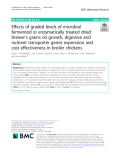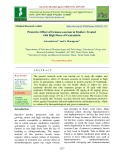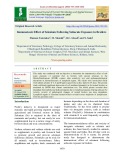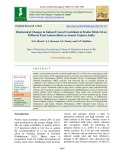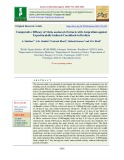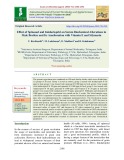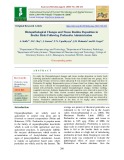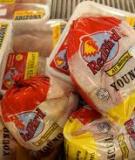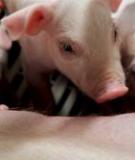
Broilers treated
-
Poultry feed consists mainly of conventional grains and protein supplements, however, using treated unconventional agro-industrial by-products as replacements of corn soybean-based diet can minimize production costs and improve productivity.
 15p
15p  vigandhi
vigandhi
 23-02-2022
23-02-2022
 14
14
 1
1
 Download
Download
-
The present research work was carried out to study the nephro and hepatoprotective effect of Ocimum sanctum in broilers exposed to high doses of gentamicin, which is common in poultry practice of Tamilnadu.
 6p
6p  chauchaungayxua11
chauchaungayxua11
 23-03-2021
23-03-2021
 7
7
 1
1
 Download
Download
-
The present study was planned to explore the possible chondroprotective effect of Withania somnifera in broilers treated with high doses of enrofloxacin.
 5p
5p  chauchaungayxua11
chauchaungayxua11
 23-03-2021
23-03-2021
 6
6
 1
1
 Download
Download
-
This study was conducted with an objective to determine the immunotoxic effect of sub acute exposure of selenium (Se) in broilers with special reference to the Dinitroflurobenzene (DNFB) contact skin sensitivity test and pathomorphological alterations in histoarchitecture of lymphoid organs. The chicks were intoxicated orally with sodium selenite @ 2, 6 and10 ppm respectively in diet, daily for 35 days. The present study exhibited significant depression of cell mediated immunity in Se treated broilers as measured by DNFB skin contact sensitization test.
 7p
7p  trinhthamhodang1213
trinhthamhodang1213
 30-05-2020
30-05-2020
 6
6
 0
0
 Download
Download
-
Studies on biochemical profile revealed significantly (P < 0.05) lower serum glucose and serum total protein, while significant increase in serum total cholesterol, Serum Glutamic Oxalo-acetic Transaminase (SGOT), Serum Glutamic Pyruvic Transaminase (SGPT) and Alkaline Phosphatase (AKP) activities was observed due to coccidial infection as compared to pre infection levels in birds. Biochemical studies indicated comparative less pathological damage by coccidiostats treatment as compared to infected non treated group, but there was no consistent trend for drug choice.
 8p
8p  nguaconbaynhay5
nguaconbaynhay5
 16-05-2020
16-05-2020
 9
9
 0
0
 Download
Download
-
The present study was planned to investigate the alternative and economical way for treating caecal coccidiosis in Broilers. An experiment was conducted to evaluate the anticoccidial efficacy of aqueous and methanolic extract of Melia azedarach (Bakain) leaves in experimentally induced Eimeria tenella infection in Broilers. Acute toxicity test of herbal extract was conducted in 21 days old broiler. The birds were observed 24 hours for sign of toxicity.
 8p
8p  kequaidan4
kequaidan4
 21-04-2020
21-04-2020
 7
7
 0
0
 Download
Download
-
The present experiment was conducted on 120 male broiler chicks which were divided into six groups of 20 each. Group 1 served as control, group 2 treated with imidacloprid @ 50 ppm in feed, group 3 was treated with spinosad @ 1000 ppm in feed, group 4 was treated with imidacloprid @ 50 ppm and spinosad @ 1000 ppm in feed, group 5 was treated with imidacloprid @ 50 ppm, spinosad @ 1000 ppm and Vitamin E @ 20 ppm in feed and group 6 was treated with imidacloprid @ 50 ppm, spinosad @ 1000 ppm and silymarin @ 1000 ppm in feed. The experiment was carried out for 4 weeks.
 7p
7p  nguathienthan4
nguathienthan4
 18-04-2020
18-04-2020
 27
27
 3
3
 Download
Download
-
To study the Histopathological changes and tissue residue deposition in broiler birds following profenofos administration. Twenty birds were divided into two groups, 10 in each group. Group I served as control and group II was treated with single oral dose of Profenofos (16 mg/kg). Representative pieces of tissues from liver, kidney, lung, brain and muscle were collected for histopathological examination and residue estimation. Birds treated with profenofos showed marked histopathological changes.
 8p
8p  trinhthamhodang4
trinhthamhodang4
 22-03-2020
22-03-2020
 8
8
 2
2
 Download
Download
-
These pest infestations are infrequent and typically limited to breeding flocks or layers. Broilers and market turkeys are seldom if ever affected. Management of ectoparasites largely consists of whole flock treatments whenever infestations are detected by scouting birds and/or inspection of the structure and equipment (nest boxes, curtains, slats, cages). Other effective management techniques are not available. It is estimated that slightly more than 4 percent of breeder birds and layers are treated for ectoparasites each year.
 17p
17p  loginnhanh
loginnhanh
 22-04-2013
22-04-2013
 52
52
 1
1
 Download
Download
-
Pesticide exposure to residues on surfaces, eggs and birds are minimal, representing little risk to workers. Once treated, birds are seldom handled by workers until removed from the houses at the end of a production cycle. Frequency of application also plays a role in reducing secondary exposure following premise treatments. Poultry houses are often treated just prior to the introduction of a new flock. In the case of broilers and young turkeys, premise treatments will occur at a minimum of every 7 to 8 weeks.
 16p
16p  loginnhanh
loginnhanh
 22-04-2013
22-04-2013
 59
59
 2
2
 Download
Download
-
The hormones which may enhance growth are actually proteins. Therefore, if they were consumed in the feed they would be digested in the same way as the corn or soybean meal that they eat. The only way for a growth hormone to be effective would be to inject it everyday in the same manner as Insulin is to treat diabetes. Logically speaking it is physically impossible to inject the 5 billion broilers grown annually in the US each and every day. Chicken growth hormone is produced for use in scientific research, which...
 5p
5p  loginnhanh
loginnhanh
 22-04-2013
22-04-2013
 44
44
 1
1
 Download
Download
CHỦ ĐỀ BẠN MUỐN TÌM









